Experimental Women In Flux
Selective Reading in the Silverman Reference Library
In 2009 The Museum of Modern Art acquired The
Gilbert and Lila Silverman Fluxus Collection—a private collection
devoted to the Fluxus art movement. Fluxus, with roots in experimental
music, emerged in the United States and Europe in the early 1960s. With
an emphasis on performance and play, Fluxus artists aimed to bring art
and life together, collapsing the traditional divisions between mediums
and undermining the authority of the artist through collaboration and
audience participation. Along with artworks and the archives of The
Gilbert and Lila Silverman Foundation, the acquisition includes the
Silverman Reference Library, a collection of more than 1,500 artists’
books, exhibition catalogues, periodicals, and scholarly works, all of
which are now held in the Museum’s library. These materials document the
activities of artists integral to Fluxus and others on the periphery of
the movement—precursors, contemporaries, and artists of succeeding
generations whose artistic practices overlapped with Fluxus in group
exhibitions, critical writing, and experimental magazines.
In this collection, which documents a
range of avant-garde activities over several decades, networks of
artists materialize in print. One conspicuous network is composed of
women—the many female artists who helped shape Fluxus aesthetics and the
numerous others associated with the group. Fluxus developed in the
decade leading up to the women’s movement, and the prevalence of female
participants in its diverse activities was unprecedented. The women
featured in this exhibition created various forms of intermedia
art—falling somewhere between visual art, poetry, performance, and sound
art; they acted as interpreters of works by others and hosted seminal
concert series that enabled avant-garde movements to flourish. In doing
so they contributed to the expanding parameters of artistic expression
that characterized their era while redefining “women’s work” for the
female artist.
The exhibition is organized by Sheelagh Bevan with David Senior, The Museum of Modern Art Library.
Action & Performance in Print
Fluxus
performance—concerned mainly with the interaction between human bodies
and the objects and actions of everyday life—debuted in 1962 in a series
of concerts across Europe organized by artist George Maciunas. The
history of performance by Fluxus women as documented in the Silverman
Reference Library is necessarily incomplete, giving only a partial view
of the live, ephemeral, and durational work, which by its nature
frustrates the limitations of print. The Library also touches on the
roots of performance art and the contemporaneous existence of Nouveau
Réalisme and Happenings—whose female participants’ contributions were
largely unacknowledged, if not anonymous.
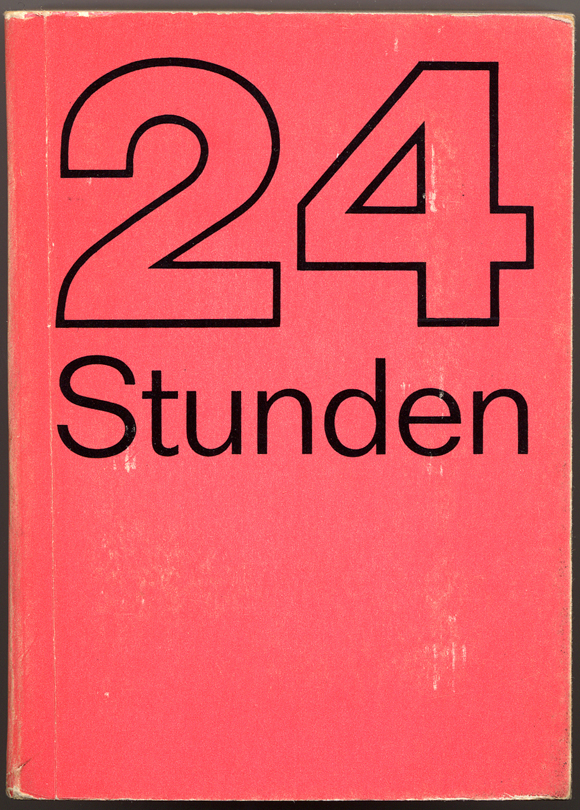 |
[top of page] Ute Klophaus. Charlotte Moorman at the Galerie Parnass, Wuppertal, June 5, 1965. In 24 Stunden (Hansen & Hansen, 1965).
Moorman was the lone female participant in the twenty-four-hour Happening 24 Stunden
(24 hours) in Wuppertal. The event’s organizers added Klophaus to the
list of participants in the catalogue, blurring the line between
documentation and participation.
|
Klein’s painting took on a performative element when he used nude women as “living paintbrushes,” making his Anthropométrie (Anthropometry) paintings in front of a seated audience.
Niki de St. Phalle, 1961. In Nouveau Réalisme, 1960/1970 (Rotonda della Besana, Comune di Milano, 1970).
St. Phalle initiated her own form of action painting in her Tir
(Shooting) series of paintings. To make the works the artist and,
later, her audience shot rifles at canvases prepared with bags of paint.
Patty Mucha. In Store Days: Documents from The Store, 1961, and Ray Gun Theater, 1962, ed. Claes Oldenburg and Emmett Williams (Something Else Press, 1967). |
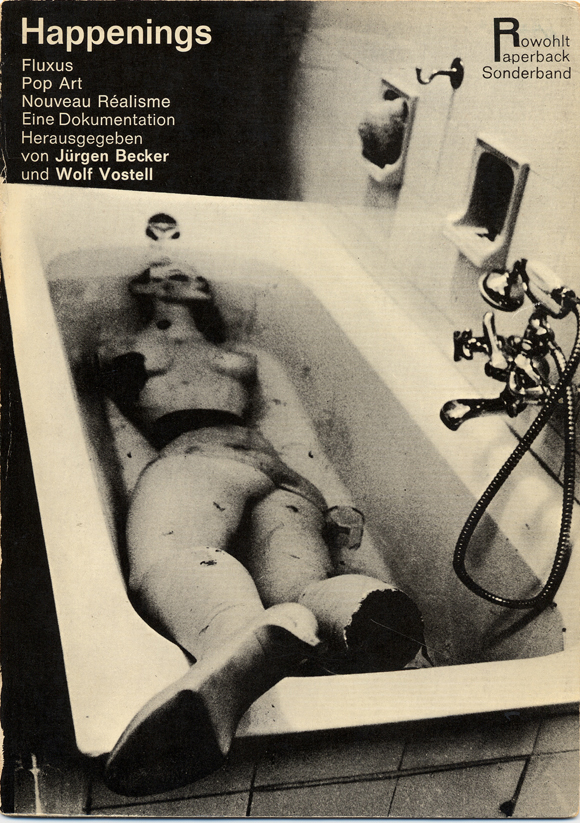 |
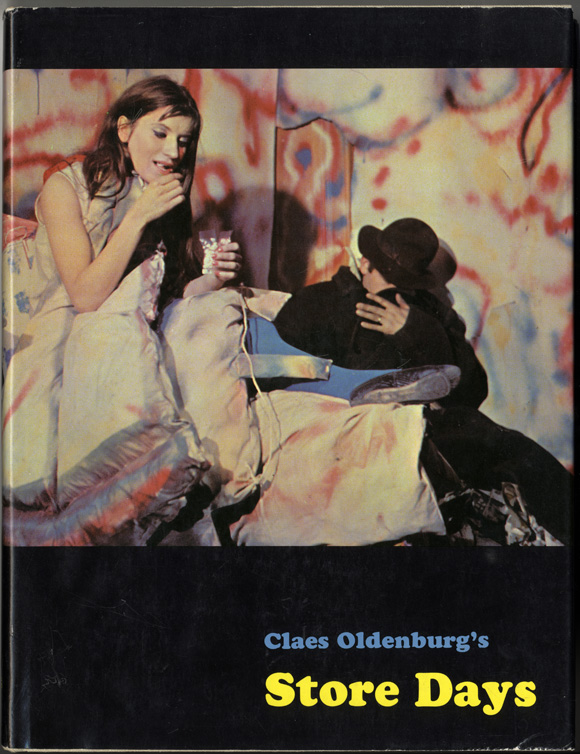
Mucha, shown here performing with Claes Oldenburg, also collaborated in sewing costumes and constructing objects and sets for Oldenburg’s Happenings and installations.
Charlotte Moorman. In 24 Stunden (Hansen & Hansen, 1965).
Moorman forged a unique career in the
gray area between composer and performer created by the opportunities
for individual interpretation in Fluxus compositions. She founded the
Annual Avant Garde Festival (1963–80) in New York, bringing together
Fluxus artists with experimental poets, artists, dancers, and musicians
of all kinds.
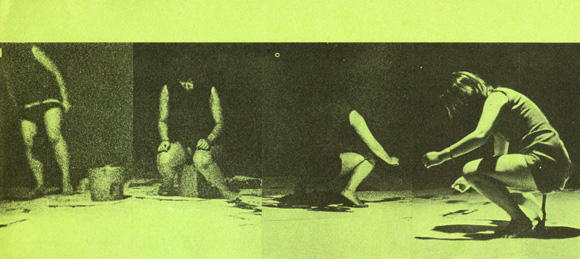
Shigeko Kubota, Yoko Ono, Mieko Shiomi,
and Alison Knowles all collaborated on performance-based works that
often took common activities as their material. These Fluxus artists
believed that the acts of preparing food, marrying, smiling, playing
games, or rustling a newspaper were forms of “social music,” making life
itself a ready-made work of art. Solo performances by women were not
always playful, however, and some took on more intimate or
confrontational tones. Women involved in Fluxus have primarily
characterized their experience in these events as liberating, as giving
them a sense of artistic independence. However, the images of women in
these early catalogues and magazines—all of which were edited by
men—tell multiple, contradictory stories of artistic agency and
vulnerability that feminists and art historians continue to debate.
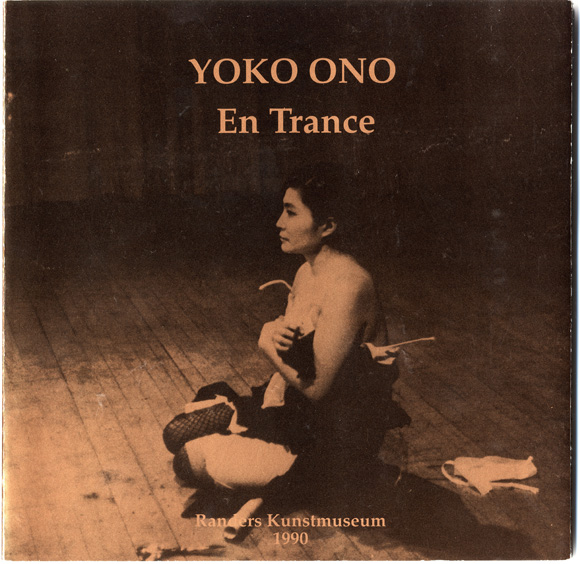 |
[left] Yoko Ono. Cut Piece. 1965. In En Trance (Randers Kunstmuseum, 1990).
Ono, like Shigeko Kubota and Mieko
Shiomi, was part of a community of Japanese experimental artists and
musicians who found artistic independence in New York. In Cut Piece
Ono signaled what was to become a life-long exploration of audience
participation. In a gesture of interactive sacrifice she invited members
of the public to cut her clothing with scissors.
[above] Shigeko Kubota. Vagina Painting. 1965. In VTRE, no. 7 (1966). Photographs by George Maciunas
|
Lette Eisenhauer in Lick Piece, by Benjamin Patterson. 1964. In Happening & Fluxus: Materialen, ed. Hanns Sohm (Koelnischer Kunstverein, 1970). Photograph by P. Moore
Alison Knowles in Danger Music, by Dick Higgins. 1961. In Happenings, Fluxus, Pop Art, Nouveau Réalisme: eine Dokumentation, ed. Jürgen Becker and Wolf Vostell (Rowohlt, 1965).
Alison Knowles remained closely involved with Fluxus
throughout the 1960s and ‘70s. She is shown here shaving the head of
fellow Fluxus artist Dick Higgins, as she performs the final part of his
five-word score: "Hat. Rags. Paper. Heave. Shave."
“Lady Mystica” in Composition for Lines and Composition for Alarm Clocks, by Bob Lens. 1964. In Fluxus in Holland: the Sixties, ed. Harry Ruhé (Galerie A/artKitchen Gallery, 2009).
Monique Smit in Sun in Your Head, by Wolf Vostell. 1964. Photo by Igno Cuypers. In Fluxus in Holland: the Sixties, ed. Harry Ruhé (Galerie A/artKitchen Gallery, 2009).
Billie Hutching and George Maciunas. Flux Wedding (Money for Food Press, 1978). Photographs by Hollis Melton
Both the social and subversive
elements of Fluxus informed the artistic presentation of the marriage of
poet Billie Hutching and Fluxus organizer George Maciunas. The bride
and groom each wore women’s gowns, then exchanged them at the altar. The
photographs, marriage certificate, and guest registry were later
published as a performance score.
|
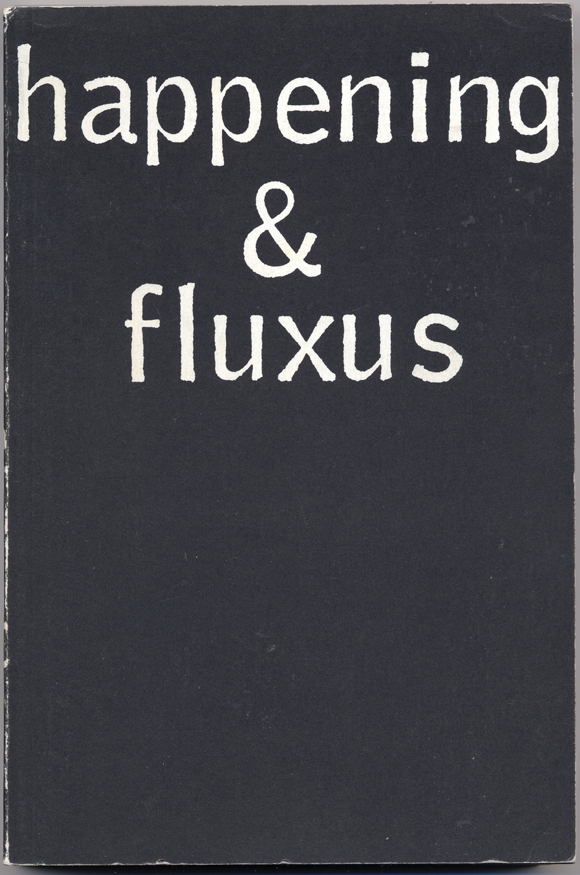 |
Textual Scores and Instructions
For artists associated with Fluxus, the concepts, from music, of the score and the arrangement
provided the structural basis of both performance and the methods of
recording it. The Silverman Reference Library contains numerous scores
and instructions for performances that expand on Fluxus artist George
Brecht’s notion that music “isn’t just what you hear . . . but
everything that happens.” These texts by women combine thought,
perception, and imagination as equal parts in a multisensory music that
relies on the reader for realization.
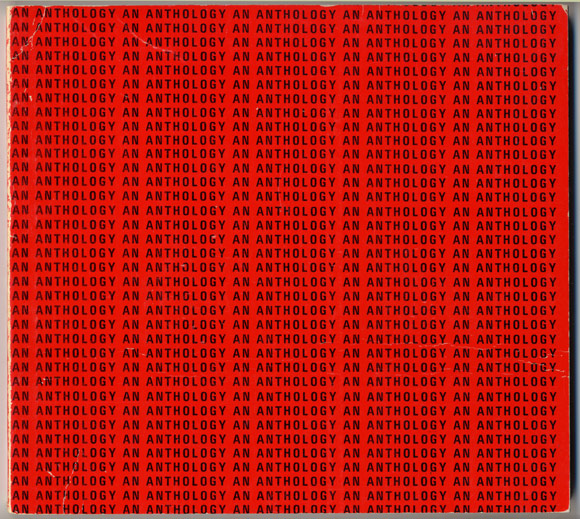
Simone Forti. [Dance Constructions]. In An Anthology, 2nd ed., ed. La Monte Young (H. Friedrich, 1970).
In the first publication to compile
scores by members of Fluxus, the dancer Forti contributed instructions
that could be performed by nondancers, realizing one of the group’s main
tenets: anyone can create art.
[below] Alison Knowles. Journal of the Identical Lunch (Nova Broadcast Press, 1971).
This book documents Knowles’s daily
lunch of a tuna sandwich at the Riss Diner in New York, while devoting
more space to the subsequent “arrangements” performed by friends and
fellow artists. She later expanded the work in a series of
screen-prints, now on view in the museum’s Contemporary galleries, and
will perform the work at MoMA in 2011.
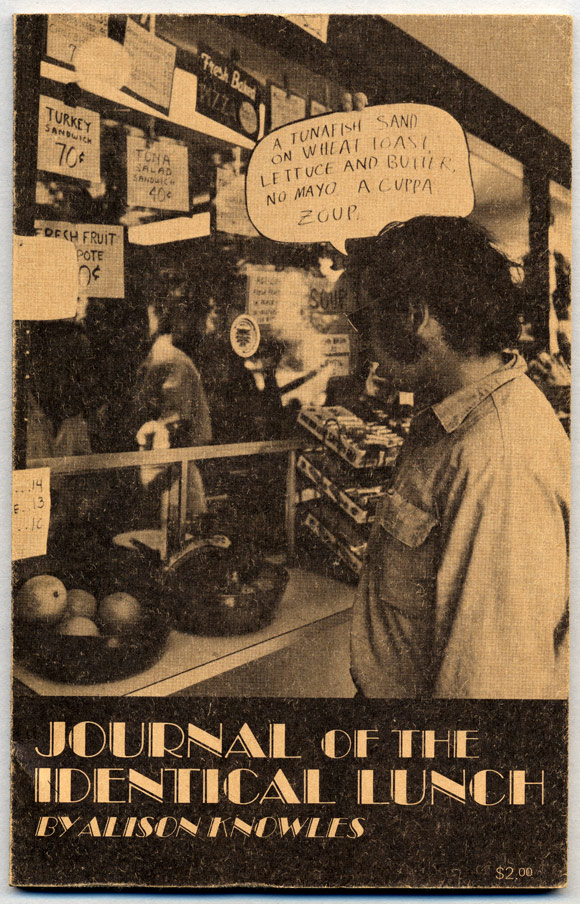 |
Philip Corner. The Identical Lunch: Performances of a Score by Alison Knowles (Nova Broadcast Press, 1973).
Fluxus artist Philip Corner
convinced Knowles to create a score from her daily meal, and later
published his own book-length arrangement of the work.
Poesie et Cetera Americaine: Biennale Internationale des Jeunes Artistes (Musée d’art moderne de la ville de Paris, 1963).
Alison Knowles’s Shuffling Piece (for audience) and Simone Forti’s Instructions pour une danse
were two of seven compositions performed simultaneously at the 1963
biennial for young artists in Paris. In the list of participants in the
back of the program, les spectateurs (the spectators) were included along with the roster of artists.
|
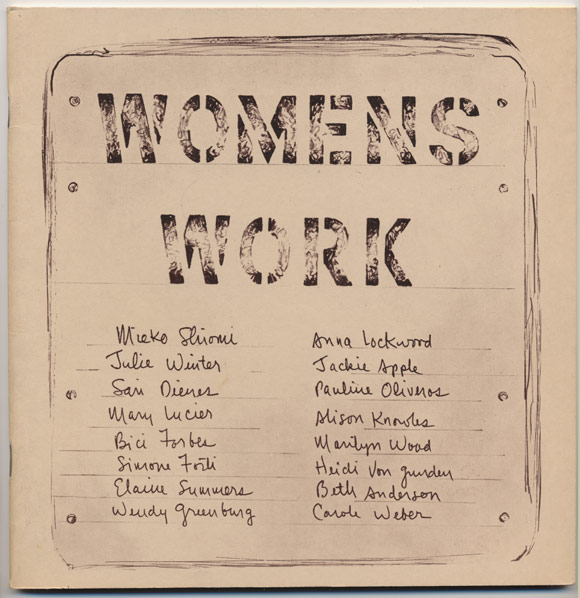
Anna Lockwood et al. Womens Work (self-published, 1975).
This collection, edited by Alison
Knowles and composer Annea Lockwood, was the first to bring together
textual scores exclusively by women.
Yoko Ono. [Scores from Grapefruit]. In Yoko Ono: To See the Skies, ed. Jon Hendricks (Mazzotta, 1990).
Ono, an early advocate of the genre, has
created, performed, and published event scores throughout her career.
Her early collection Grapefruit (1964) was the first ever presentation of textual scores by a single artist in book form.
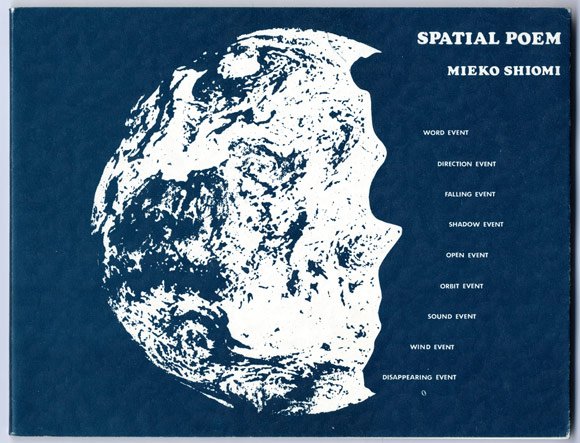
Mieko Shiomi. Spatial Poem (M. Shiomi, 1976).
Mieko Shiomi. Invitation to Spatial Poem no. 4. 1975
Mieko Shiomi. Invitation to Spatial Poem no. 4. 1975
Shiomi demonstrated the collaborative aspect of Fluxus and the group’s influence on developments in mail art in Spatial Poem
(1965–75), a “global event” in which she enlisted artists through the
mail to document their participation in her intimate action poems.
Esther Ferrer. Le Fil du Temps. In Esther Ferrer: Ekintzatik Objektura, Objektutik Ekintzara (Gipuzkoako Foru Aldundia, 1997).
One person sits on a chair. From the ceiling, a
very fine thread starts falling. The person remains seated until the
thread covers him/her completely.
Ferrer incorporates drawings and
related installations into her texts. She often emphasizes the absurdity
of life by including suicide as one possible outcome of her actions. An
early member of the experimental music and performance group Zaj, based
in Spain, Ferrer today remains committed to exploring the concept of
performance in multiple mediums.
Katalin Ladik. Novi Sad (Projects). Wow, Special Zagreb Number, ed. Bosch + Bosch (1975).
|
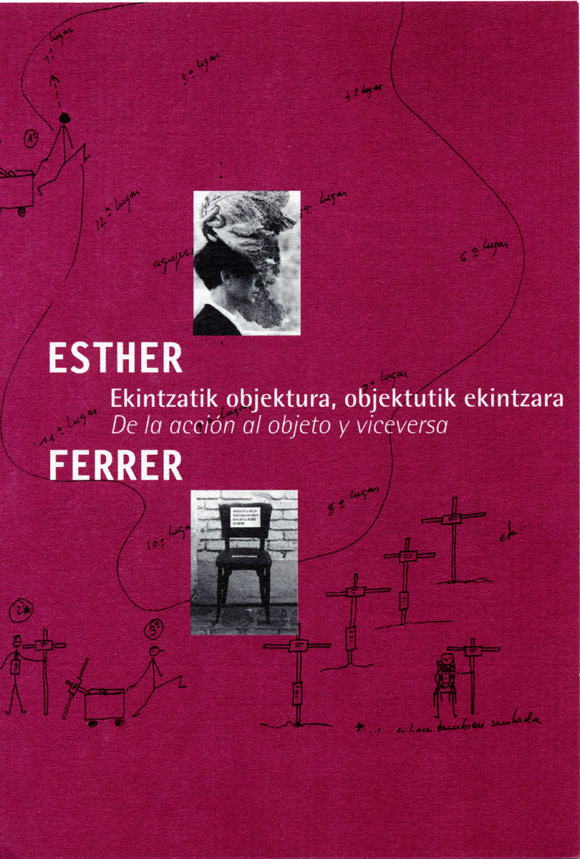 |
Ladik’s scores elicit reflections on and
interventions into the physical environment of Novi Sad, Serbia. Ladik
was the only female member of Bosch + Bosch, an art collective based in
Subotica, Serbia, whose diverse activities touched on performance,
Conceptual art, land art, sound art, and visual poetry.
Visual Music
Graphic notation—the use of symbols,
images, and texts to transcribe music—emerged in the middle of the
twentieth century, as composers began to investigate the borders between
musical notation and visual art. For Fluxus artists, many of whom had
been classically trained in the field, music served both as a mode of
composition and a medium of sound and visual art. Producing works that
employ combinations of drawing, calligraphy, texts, and collage, women
created their own systems of notation. Other women artists in dialogue
with the group worked closely with composers to interpret or enhance
music through the traditional mediums of painting, sculpture, and
photography. Male composers inserted the female body into new types of
symphonic scores as a compositional element, but this objectification
was countered by the prolific production of women—a small selection of
which appears here.
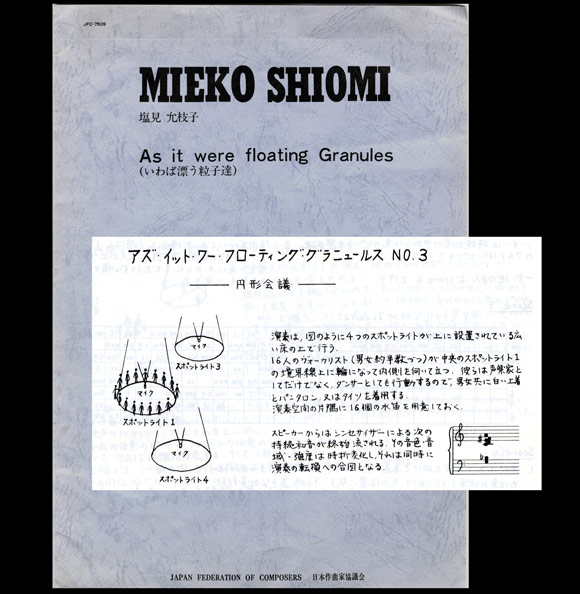
Mieko Shiomi. As It Were Floating Granules (Japan Federation of Composers, 1976).
Shiomi was a cofounder of the Japanese
experimental music collective Group Ongaku, with which she collaborated
before and after her Fluxus years in New York. This six-part work—a
chance composition for vocal groups and instrumentalists—employs a range
of graphic notational systems and texts in English and Japanese.
Mieko Shiomi. Lyric Suite (Self-published, c. 1973).
This is one of six collages in Shiomi’s visual music portfolio Lyric Suite.
More than any other female member of Fluxus, Shiomi, in her work as
composer, visual artist, and performer, repeatedly returns to music as a
ground for experimentation.
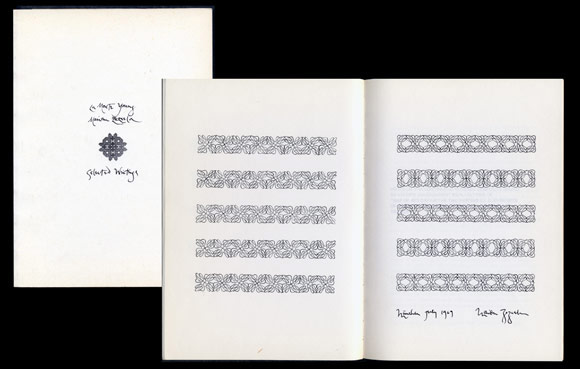
Marian Zazeela. Lines. In Selected Writings, Copyright © La Monte Young and Marian Zazeela 1969 (Heiner Friedrich, 1969, Munich)
Zazeela’s use of systems of abstract calligraphy in
her work in the early 1960s is evidenced by the posters and cover art
she designed for Young, a composer. As their close collaboration
progressed, Zazeela inflected these inscriptions with color, expanding
them into innovative light installations that formed an integral part of
Young’s musical performances.
Dora Maurer. Time Pieces. In Source, no. 11 (1972).
Maurer, a filmmaker and visual artist,
used photography and a language of time to depict the underlying
structure of music. This work appeared as part of an exhibition-in-print
on contemporary approaches to music, published in the avant-garde music
magazine Source.
Alison Knowles. Blue Ram. 1967. In Notations, by John Cage (Something Else Press, 1969).
Knowles helped to design and edit Cage’s
compilation of new musical scores. Her own contribution to the
collection is a composition involving four performers, sound-making
objects, and six illustrated cards.
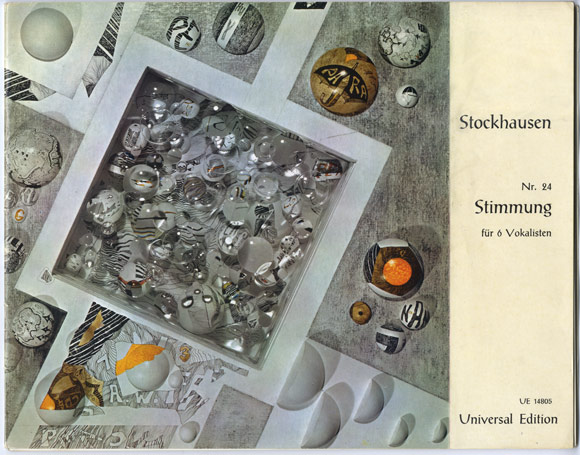
Mary Bauermeister. Peng-cil. 1966. In Stimmung, für 6 Vokalisten, nr. 24, by Karlheinz Stockhausen (Universal Edition, 1969). Library copy
Bauermeister’s Cologne atelier was a
center of experimental music for the European and American avant-garde,
some of whom became involved with Fluxus. Bauermeister’s approach to
painting inspired Karlheinz Stockhausen, the electronic-music composer,
and their work was exhibited together in multimedia exhibitions. As part
of the score for Stockhausen’s musical play Originale (1961), Bauermeister painted onstage—a feat she later repeated alongside Fluxus artists at Charlotte Moorman’s Annual Avant Garde Festival.
Nam June Paik. Symphony no. 5. 1965. In Happenings, Fluxus, Pop Art, Nouveau Réalisme: eine Dokumentation, ed. Jürgen Becker and Wolf Vostell (Rowohlt, 1965).
Mieko Shiomi. Selections from Fluxus Suite: A Musical Dictionary of 80 People around Fluxus
(? Records, 2002).
(? Records, 2002).
Shiomi composed musical portraits of eighty figures associated with Fluxus. These selections represent Jean Brown, Esther Ferrer, Alice Hutchins, Alison Knowles, Shigeko Kubota, Barbara Moore, Charlotte Moorman, Pauline Oliveros, Yoko Ono, Takako Saito, Carolee Schneemann, Mieko Shiomi, and Marian Zazeela.
Forms of Writing
For women artists associated with
Fluxus, language was a site of aesthetic inquiry and play. The textual
elements of many Fluxus artworks led to their inclusion in literary
collections and underground magazines at a time when American art
magazines did not devote much space to the group. In the little
magazines of the 1960s and 1970s, work by Fluxus writers is presented
beside work by the Beats, new poets of San Francisco, New York, and
England, and visual poets from around the world, some of whom were also
exploring the use of sound, images, and new technology in language arts.
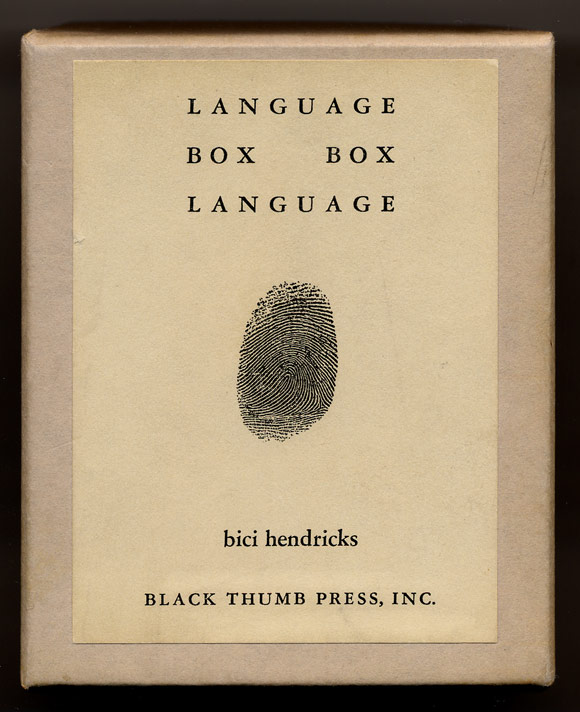 |
Bici Hendricks. Language Box, Box Language (Black Thumb Press, 1966).
Nye Ffarrabas, known then as Bici
Hendricks, has described her book as a game without rules, invoking the
“serious play” of children, who need no instructions to use a sandbox
but simply start digging. The reader initiates his or her own process of
creative synthesis, choosing to manipulate, arrange, define, or ignore
the words printed on each side of the cards.
|
Seng Ts’an. Hsin hsin ming. Calligraphy by Takako Saito, translated by George Brecht, Albrecht Fabri, and Robert Filliou (Lebeer Hossmann, 1980).
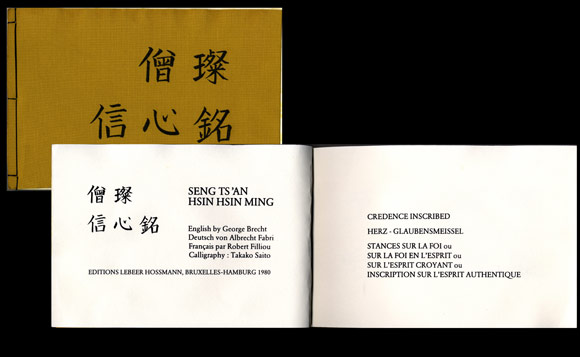
The collaborative nature of Fluxus and
its members’ shared interest in Zen Buddhism found a linguistic outlet
in this polyglot translation of Seng Ts’an’s seventh-century writings on
Chinese Buddhism, for which Saito provided the calligraphy in k’ai shu style.
Tamara Janković. Šesta Dimenzija 16 and Šesta Dimenzija 17. In Signal, no. 1 (1970).
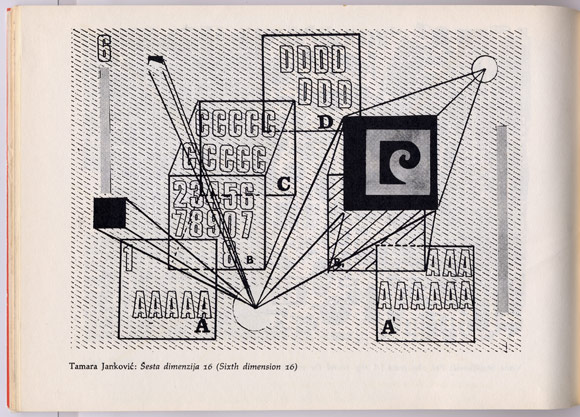
Janković was a member of the
Belgrade-based Signalist group of experimental poets in the early 1970s
and was on the editorial board for the group’s magazine, Signal.
Her use, here, of numbers, letters, and the Pierre Cardin logo reflects
the Signalist goal to explore symbols and imagery in new poetry that
transcends national languages.
Carolee Schneemann. Meat Joy Notes as Prologue. In Some/thing 1, no. 2 (1965).
Schneemann created a new, bilingual work from her notes to her stage performance Meat Joy with this playful technique: “The French text was made from a dictionary and a picture book, Look and Learn, then collaged and superimposed on the English, along with the sound of a ticking clock.”
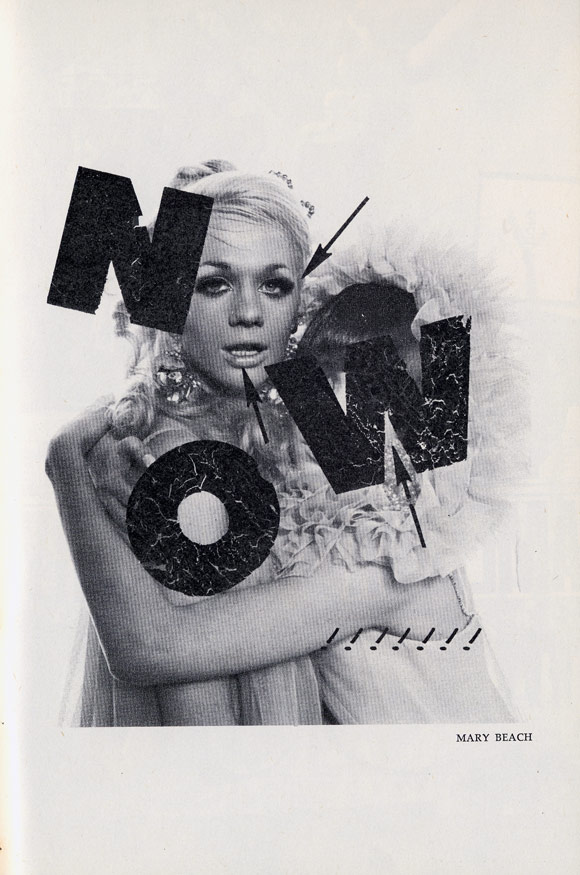
Mary Beach. Concrete poem. In The San Francisco Earthquake 1, no. 3 (1968).
Beach’s calligraphs, Concrete poems, and
experimental prose circulated along with works by Carol Bergé, Diane di
Prima, and Diane Wakoski in the network of publications in which
Fluxus, Beat poetry, and other underground writing converged.
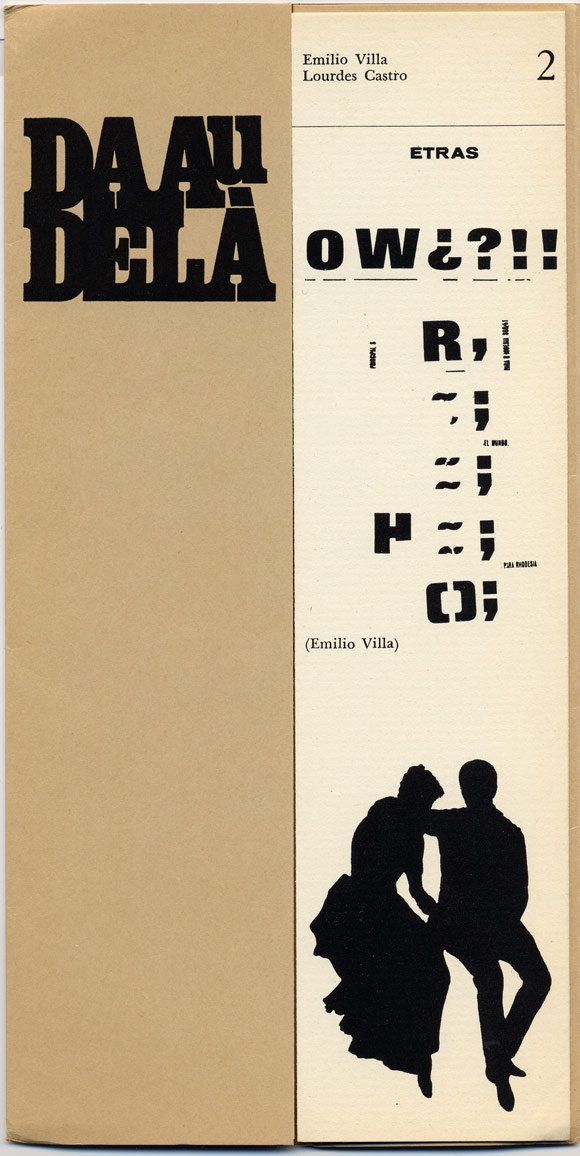 |
Lourdes Castro and Emilio Villa. Visual Poem (Untitled)In Da-a/u dela, no. 1 (1966).
To this collaboration with Villa,
an Italian experimental poet, Castro contributed male and female
silhouettes whose ambiguous embrace invites the reader to interpret
Villa’s symbols above. Castro was a coeditor of the artists’ magazine KWY, which published poetic and visual works by Fluxus artists.
Yvonne Rainer. Three Distributions. In Aspen, no. 8 (1970-71).
Rainer, a dancer and filmmaker,
transcribed movement using text, graphic diagrams, and images of bodies
in her contribution to the Fluxus issue of Aspen.
|
Mediating the Body
Fluxus performers staged their bodies in
social, interactive spaces, drawing attention to everyday tasks,
movements, and objects. Women artists who made explicit and erotic uses
of their bodies in their work sometimes sensed disapproval from the
group. Shigeko Kubota recalls that her fellow Fluxus artists were
visibly displeased by the graphic nature of Vagina Painting (1965),
while Carolee Schneemann became alienated from Fluxus organizer George
Maciunas following the productions of her sensual stage show Meat Joy
(1964). Fluxus women and those on the periphery of the movement
continued to investigate the body in different mediums, exploiting the
immediacy of performance and the more distanced confrontations enabled
by visual art, the book arts, and video. These exhibition catalogues and
artists’ books document some of these uses of the naked female form.
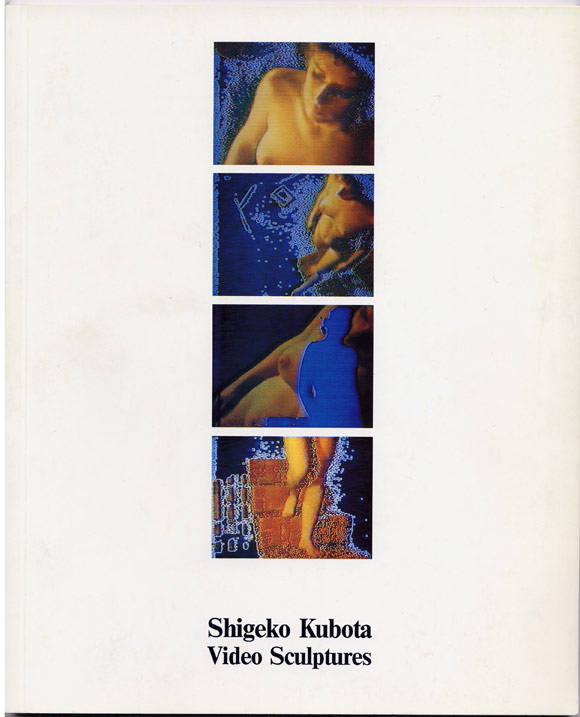
Shigeko Kubota. Nude Descending a Staircase. 1975–76. In Shigeko Kubota: Video Sculptures, ed. Zdenek Felix (Museum Folkwang Essen, 1981).
Following her early Fluxus performances
and objects, Kubota began the pioneering career in video art and
installation in which she continues to investigate the landscapes of the
body and the natural world. In this homage to her mentor Marcel
Duchamp, Kubota deconstructs the moving body of filmmaker Sheila
McClaughlin to produce a new iteration of Duchamp’s painting of the same
title.
Carolee Schneemann. Meat Joy (1964) and Fluxus (1990). In Ubi Fluxus Ibi Motus: 1990–1962, ed. Achille Bonito Oliva (Mazzotta, 1990).
Fluxus can be lots of fun when the boys let you on their boat / sometimes they throw you off the boat. / . . .
/ if you dont wear underpants or show your pussy you get pushed / over the side.
/ if you dont wear underpants or show your pussy you get pushed / over the side.
Schneemann’s
explorations of eros in her maverick stage performances pioneered the
American genre called body art. In this catalogue for a 1990 Fluxus
exhibition, Schneemann paired sensuous imagery from Meat Joy with a retrospective statement about the group.
Friederike Pezold. Die Schwarz-Weisse Göttin und ihre Neue Leibhaftige Zeichensprache (Staatliche Kunsthalle, 1977).
Pezold’s early artists’ books,
published by Reflection Press (run by Fluxus participant Albrecht d.),
address issues of women in art in the early 1970s. In later performance,
film, writings, and visual art Pezold reduced the female body to
abstract hieroglyphics and often recomposed these elements in
photographic installations and video sculptures.
|
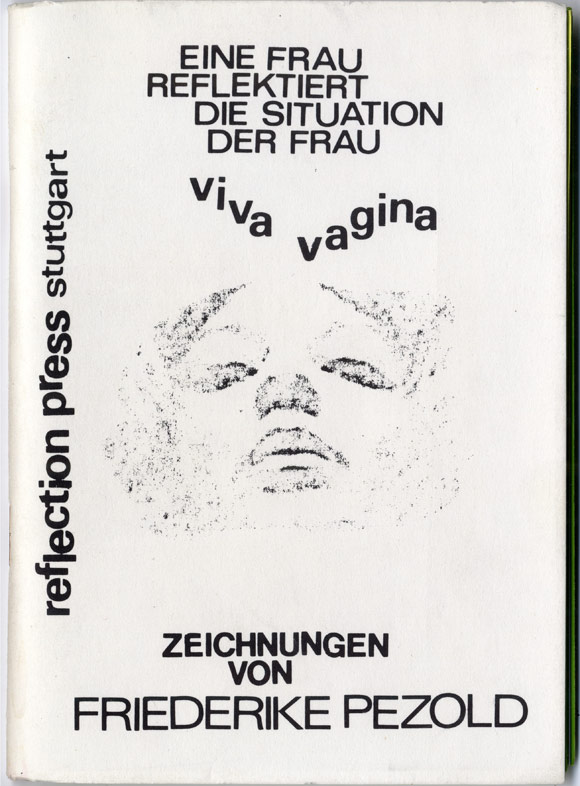 |
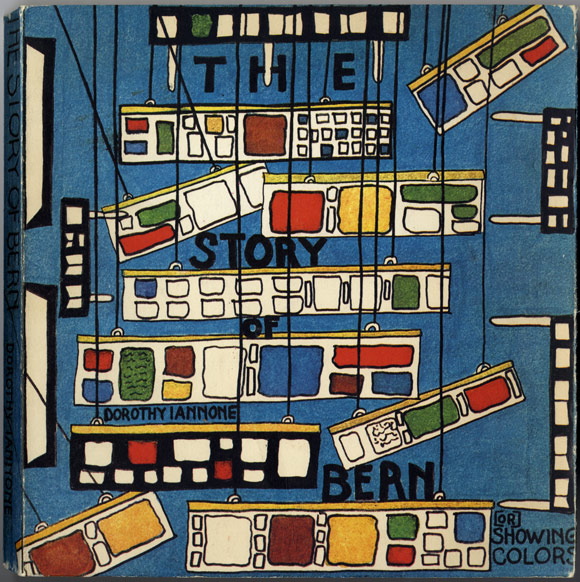
Dorothy Iannone. The Story of Bern, or Showing Colors (Dieter Roth and D. Iannone, 1970).
Iannone takes as her subject the
interrelations of love, sex, and spirituality. Although she is not
viewed as a full member of the group, Iannone contributed to Fluxus
publications and formed part of a social circle that included artists
Emmett Williams and Dieter Roth. At a 1969 exhibition in Bern, her
explicit imagery of male and female genitalia was censored. Roth
withdrew his works from the show in protest and the gallery’s director,
Harald Szeemann, resigned. Iannone processed the experience in this
artist’s book, which illustrates the scandal in detail.
Helen Chadwick. Of Mutability (London Institute of Contemporary Arts, 1986). Library copy
Chadwick was part of the vibrant Fluxus
community in England in the early 1970s. In these blue photocopied
collages Chadwick refers to Edmund Spenser’s Renaissance verses on the
forces of flux and entropy inherent to the universe, depicting her own
body within an amniotic environment of decaying organic matter.
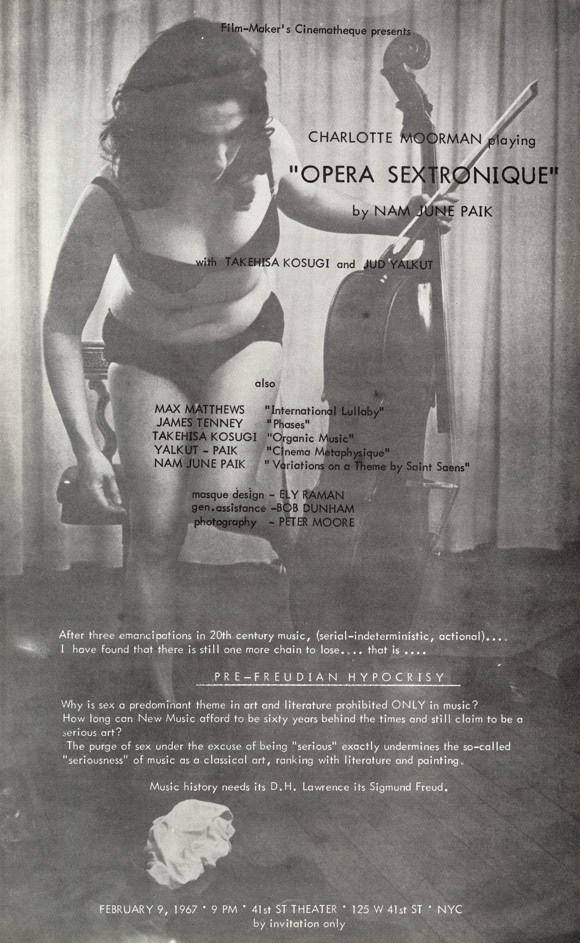
Charlotte Moorman. Flyer for Opera Sextronique. In The World of Charlotte Moorman Archive Catalog, ed. Barbara Moore (Bound & Unbound, 2000). Library copy
Moorman used her
body as a “living sculpture,” often performing in various states of
undress and costume. After removing her bikini top at a 1967 performance
of Opera Sextronique in New York—one of her many
collaborations with Nam June Paik—she was arrested, charged, and given a
suspended sentence for lewdness, becoming known in the media as “the
topless cellist.”
Kate Millet. Sexual Politics (Doubleday, 1970).
Fluxus artist Kate Millet combined
cultural and literary criticism in a work that became an important text
for the developing fields of women’s studies and feminist theory.
Book-making
| The emergence of artists’ books toward the end of the 1960s is inextricably linked to Fluxus and the Museum Library. Members of the group contributed to the early production of printed matter, which helped to set the stage for later developments in the genre. The women artists featured here created—and continue to create—conceptual, poetic, and narrative works, books as sculptural installations and as objects, and are also printers, publishers, editors, book dealers, and archivists. When the Silverman Reference Library was acquired, copies of some of its works were already in different sections of the Library—many in the | 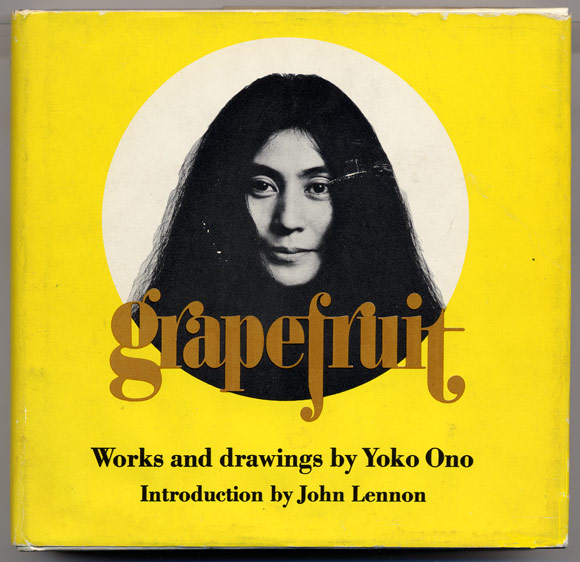 |
| Franklin Furnace Artists’ Books Collection—revealing intersections among collecting practices that speak to the influence of Fluxus on the contemporary book arts and the institutions dedicated to preserving the book as a work of art. | |
Alison Knowles. The Big Book. In Décollage, no. 6 (1967).
Knowles’s walk-through installation The Big Book
included objects and images of daily living—a saucepan, a telephone, a
toilet—within a three-dimensional framework of eight-foot “pages.”
Knowles’s work is performative in function, inviting bodies to
experience the space in time, through their own, indeterminate
“readings.”
Peter Moore. The Big Book, by Alison Knowles. c. 1967. Franklin Furnace Artist Files. © Estate of Peter Moore / VAGA, New York
Takako Saito. Die Chinesisch Tusch Zeichnungen auf dem Düsseldorf Wasser (Noodle Edition, 1985).
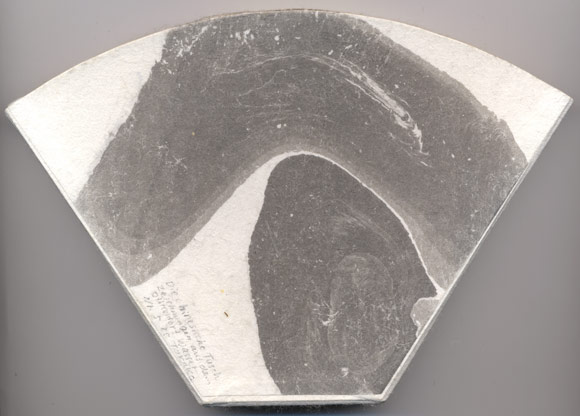
A prolific artist of sculptural book
forms and book objects, Saito suggests the melancholy of self-exile
through the daily detritus of used coffee filters, connecting her Asian
origins to the country in which she lives by combining Chinese ink with
German water.
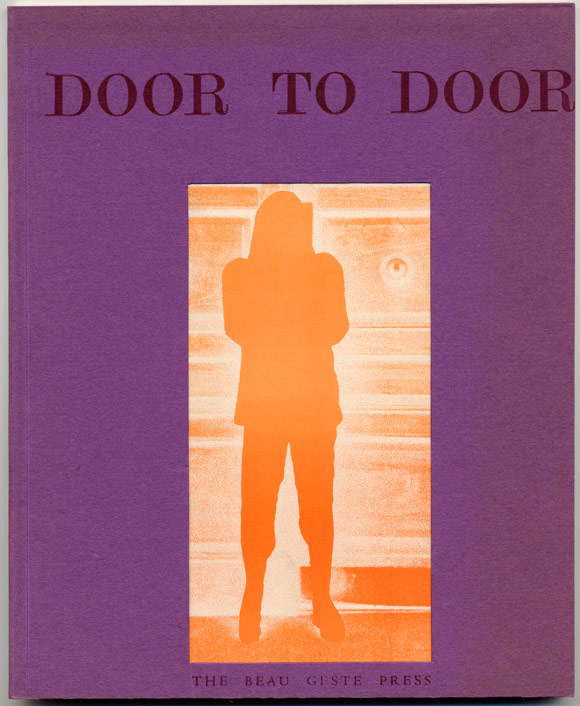
Helen Chadwick and David Mayor. Door to Door (Beau Geste Press, 1973).
In Croydon, two doors face each other across a lawn.
The contesting pagination in Chadwick
and Mayor’s conceptual photobook draws the reader simultaneously
backward and forward through the book. Chadwick’s figure, captured from
near and far, parallels this spatial disorientation by seeming to
magically move from one distant doorway to another.
Barbara Moore. Cookpot (ReFlux Editions, 1985). Reproduction of cover image supplied by B. Moore, 2010.
Individual personalities and practices
inflect each contributor’s notion of what constitutes cooking in Moore’s
collection of recipes by friends and fellow artists. Carolee
Schneemann, for example, prescribes multiple roles for one cantaloupe:
dried beads for children, food for cats, material for a facial, and,
finally,
a high-protein breakfast.
a high-protein breakfast.
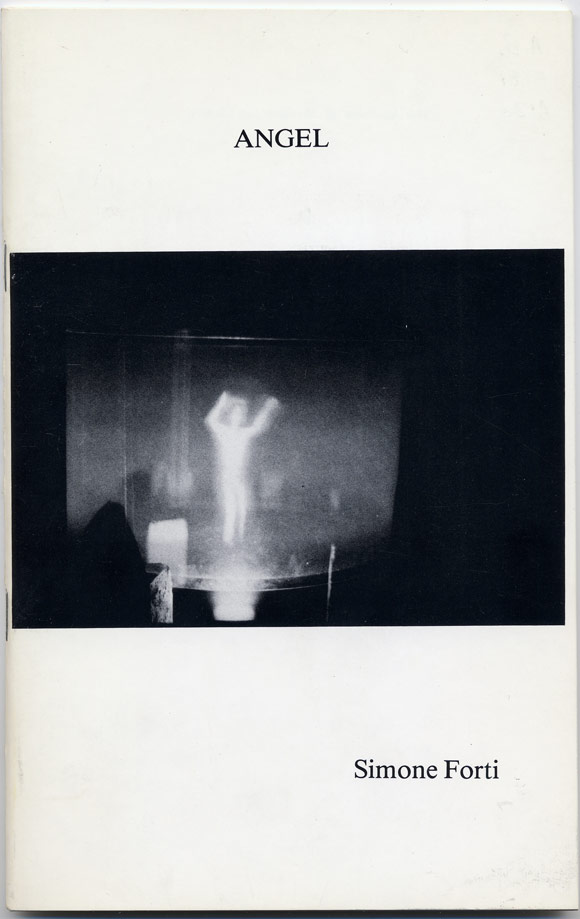 |
Simone Forti. Angel (Self-published, 1978). Franklin Furnace Artists’ Books Collection
Forti’s book of short prose poems and photographs
produces a nonlinear narrative of thought and memory that reflects the
artist’s changing engagement with her work and life.
Lourdes Castro. D’Ombres (G. Schraenen, 1974). Franklin Furnace Artists’ Books Collection
Using a combination of colored sheets, vellum, and transparent covers, Castro used photographs from her Théâtre d’Ombres
project as the basis for this screenprinted artist’s book. Her
silhouetted figure, almost indistinguishable from the shadowy objects
around her, suggests both presence and absence.
As she moves through the book, Castro’s form “comes to life” even as it appears to dematerialize in front of the reader’s eyes. |
Citations (from top) and Additional Texts
Charlotte Moorman at 24 Stunden, a Happening at Galerie Parnass, Wuppertal, 1965. In 24 Stunden (Hansen & Hansen, 1965). Photograph by Ute Klophaus
24 Stunden. Hansen & Hansen, 1965
Happenings, Fluxus, Pop art, Nouveau Réalisme: eine Dokumentation, ed. Jürgen Becker and Wolf Vostell (Rowohlt, 1965)
Store Days: Documents from The Store, 1961, and Ray Gun Theater, 1962, ed. Claes Oldenburg and Emmett Williams (Something Else Press, 1967)
Shigeko Kubota. Vagina Painting. 1965. In VTRE, no. 7 (1966). Photographs by George Maciunas
Yoko Ono: En Trance, tilrettelagt af Jon Hendricks og Birgit Hessellund (Randers Kunstmuseum, 1990)
Happenings, Fluxus, Pop art, Nouveau Réalisme: eine Dokumentation, ed. Jürgen Becker and Wolf Vostell (Rowohlt, 1965)
Store Days: Documents from The Store, 1961, and Ray Gun Theater, 1962, ed. Claes Oldenburg and Emmett Williams (Something Else Press, 1967)
Shigeko Kubota. Vagina Painting. 1965. In VTRE, no. 7 (1966). Photographs by George Maciunas
Yoko Ono: En Trance, tilrettelagt af Jon Hendricks og Birgit Hessellund (Randers Kunstmuseum, 1990)
An Anthology, 2nd ed., ed. La Monte Young (H. Friedrich, 1970)
Alison Knowles. Journal of the Identical Lunch (Nova Broadcast Press, 1971)
Womens Work, ed. Anna Lockwood and Alison Knowles (Self-published, 1975)
Mieko Shiomi. Spatial Poem (Self-published, 1976)
Esther Ferrer: Ekintzatik Objektura, Objektutik Ekintzara. Gipuzkoako Foru Aldundia, 1997. Promotional postcard
Alison Knowles. Journal of the Identical Lunch (Nova Broadcast Press, 1971)
Womens Work, ed. Anna Lockwood and Alison Knowles (Self-published, 1975)
Mieko Shiomi. Spatial Poem (Self-published, 1976)
Esther Ferrer: Ekintzatik Objektura, Objektutik Ekintzara. Gipuzkoako Foru Aldundia, 1997. Promotional postcard
Mieko Shiomi. As It Were Floating Granules (Japan Federation of Composers, 1976)
Marian Zazeela. Lines. In Selected Writings, Copyright © La Monte Young and Marian Zazeela 1969 (Heiner Friedrich, 1969, Munich)
Karlheinz Stockhausen. Stimmung, für 6 Vokalisten, nr. 24 (Universal Edition, 1969)
Bici Hendricks. Language Box, Box Language (Black Thumb Press, 1966)
Seng Ts’an. Hsin hsin ming. Calligraphy by Takako Saito, translated by George Brecht, Albrecht Fabri, and Robert Filliou (Lebeer Hossmann, 1980)
Tamara Janković. Šesta Dimenzija 16. In Signal, no. 1 (1970)
Mary Beach. Concrete poem. In The San Francisco Earthquake 1, no. 3 (1968)
Lourdes Castro and Emilio Villa. Visual Poem (Untitled). In Da-a/u dela, no. 1 (1966)
Marian Zazeela. Lines. In Selected Writings, Copyright © La Monte Young and Marian Zazeela 1969 (Heiner Friedrich, 1969, Munich)
Karlheinz Stockhausen. Stimmung, für 6 Vokalisten, nr. 24 (Universal Edition, 1969)
Bici Hendricks. Language Box, Box Language (Black Thumb Press, 1966)
Seng Ts’an. Hsin hsin ming. Calligraphy by Takako Saito, translated by George Brecht, Albrecht Fabri, and Robert Filliou (Lebeer Hossmann, 1980)
Tamara Janković. Šesta Dimenzija 16. In Signal, no. 1 (1970)
Mary Beach. Concrete poem. In The San Francisco Earthquake 1, no. 3 (1968)
Lourdes Castro and Emilio Villa. Visual Poem (Untitled). In Da-a/u dela, no. 1 (1966)
Shigeko Kubota: Video Sculptures, ed. Zdenek Felix (Museum Folkwang Essen, 1981)
Friederike Pezold. Eine Frau Reflektiert die Situation der Frau : Viva Vagina (Reflection Press, 1973)
Dorothy Iannone. The Story of Bern, or Showing Colors (Dieter Roth and D. Iannone, 1970)
Flyer for Opera Sextronique. In The World of Charlotte Moorman Archive Catalog, ed. Barbara Moore (Bound & Unbound, 2000).
Friederike Pezold. Eine Frau Reflektiert die Situation der Frau : Viva Vagina (Reflection Press, 1973)
Dorothy Iannone. The Story of Bern, or Showing Colors (Dieter Roth and D. Iannone, 1970)
Flyer for Opera Sextronique. In The World of Charlotte Moorman Archive Catalog, ed. Barbara Moore (Bound & Unbound, 2000).
Yoko Ono. Grapefruit: a Book of Instructions. Simon and Schuster, 1970
Takako Saito. Die Chinesisch Tusch Zeichnungen auf dem Düsseldorf Wasser (Noodle Edition, 1985)
Helen Chadwick and David Mayor. Door to Door (Beau Geste Press, 1973)
Simone Forti. Angel (Self-published, 1978)
Takako Saito. Die Chinesisch Tusch Zeichnungen auf dem Düsseldorf Wasser (Noodle Edition, 1985)
Helen Chadwick and David Mayor. Door to Door (Beau Geste Press, 1973)
Simone Forti. Angel (Self-published, 1978)
Further Reading
Fluxus, etc.: the Gilbert and Lila Silverman Collection, ed. Jon Hendricks. Bloomfield Hills, Mich.: Cranbrook Academy of Art Museum, 1981.
Hannah Higgins. Fluxus experience. Berkeley: University of California Press, c2002.
Ubi Fluxus Ibi Motus, 1990-1962, ed. Achille Bonita Oliva. Milano: Mazzotta, 1990.
Women & Fluxus: Toward a feminist archive of Fluxus, ed. Midori Yoshimoto. Special issue of Women & Performance: a journal of feminist theory, vol. 19, no. 3 (2009).
Midori Yoshimoto. Into Performance: Japanese Women Artists in New York. New Brunswick, NJ: Rutgers Univ. Press, 2005.
All material in this exhibition is held by The Museum of Modern Art Library. Contact library@moma.org for an appointment.
Acknowledgements
Special thanks to Jon Hendricks, Barbara Moore, Mieko Shiomi, Ute Klophaus and Armin Hundertmark.Also thanks to Rebecca Roberts, Sara Bodinson, David Hart, Julianna Goodman, Chiara Bernasconi, Jessica Nutting, Roberto Rivera, Robert Kastler, Thomas Griesel, Charlie Kalinowski, Milan Hughston and the entire MoMA Library staff.
(((SOURCELINK)))


This comment has been removed by the author.
ReplyDeleteThis comment has been removed by the author.
ReplyDeleteThis comment has been removed by the author.
ReplyDeleteThis comment has been removed by the author.
ReplyDeleteThis comment has been removed by the author.
ReplyDelete
ReplyDeleteGreat information here. Thank you for sharing. If you are ever in a need of
locksmith denver Services we are Aurora Locksmith Services. You can find us at auroralocksmithco.com.com or call us at: (720) 220-4851.
This comment has been removed by the author.
ReplyDelete